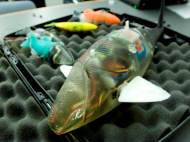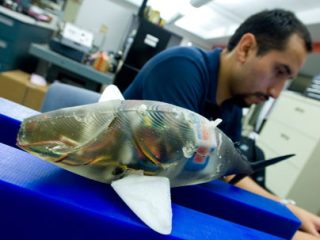Robo-fish from MIT
 A team of MIT researchers has built a school of swimming robo-fish that slip through the water just as gracefully as the real ones, but not quite as fast. Real fish are exquisitely adapted to moving through their watery environment, and can swim as fast as 10 times their body length per second. So far, the MIT researchers have gotten their prototypes close to one body length per second – much slower than their natural counterparts but faster than earlier generations of robotic fish.
A team of MIT researchers has built a school of swimming robo-fish that slip through the water just as gracefully as the real ones, but not quite as fast. Real fish are exquisitely adapted to moving through their watery environment, and can swim as fast as 10 times their body length per second. So far, the MIT researchers have gotten their prototypes close to one body length per second – much slower than their natural counterparts but faster than earlier generations of robotic fish.
Mechanical engineers Kamal Youcef-Toumi and Pablo Valdivia Y Alvarado have designed the sleek robotic fish to more easily maneuver into areas where traditional underwater autonomous vehicles can’t go. Fleets of the new robots could be used to inspect submerged structures such as boats and oil and gas pipes; patrol ports, lakes and rivers; and help detect environmental pollutants.
“Given the (robotic) fish’s robustness, it would be ideal as a long-term sensing and exploration unit. Several of these could be deployed, and even if only a small percentage make it back there wouldn’t be a terrible capital loss due to their low cost,” says Valdivia Y Alvarado.
Robotic fish are not new: In 1994, MIT ocean engineers demonstrated Robotuna, a four-foot-long robotic fish. But while Robotuna had almost three thousand parts controlled by six motors, the new robotic fish (less than 30cm long) are powered by a single motor and are made of fewer than 10 individual components, including a flexible, compliant body that houses all components and protects them from the environment. The motor, placed in the fish’s midsection, initiates a wave that travels along the fish’s flexible body, propelling it forward.
The robo-fish bodies are not divided into different segments, flexible and made from soft polymers. This makes them more maneuverable and practically mimics the swimming motion of a real fish, which propel themselves by contracting muscles on either side of their bodies, generating a wave that travels from head to tail.
As part of his doctoral thesis, Valdivia Y Alvarado created a model to calculate the optimal material properties distributions along the robot’s body to create a fish with the desired speed and swimming motion. The model also takes into account the robot’s mass and volume. A more detailed model is described in Valdivia Y Alvarado’s thesis and will soon be published along with new applications by the group.
These robotic fish are more durable than their robotic predecessors – with their seamless bodies, there is no chance of water leaking into the robots and damaging them. Several four-year-old prototypes are still functioning after countless runs through the testing tank, which is filled with tap water.
Current prototypes require 2.5 to 5 watts of power, depending on the robot’s size. That electricity now comes from an external source, but in the future the researchers hope to power the robots with a small internal battery.
With motors in their bellies and power cords trailing as they swim, the robo-fish might not be mistaken for the real thing, but they do a pretty good fish impersonation. Later this fall, the researchers plan to expand their research to more complex locomotion and test some new prototype robotic salamanders and manta rays.











hi!
i want to make robot fish .because i like that.can you help me?
i study in university .i study computer .excuse me i cant write good English.
can you send me photo from your work?you are professional in this work.thanks.
dear sir,
i am very much fascinated about underwater world, as i am mechanical engineer, so i decided to make something that make underwater accessible to human being, surfing through the internet i found your robofish, and i am very excited to know about this, please help me i want to know about the motors, sealing, power and submerging and emerging capabilities. please respond to this